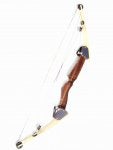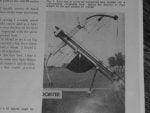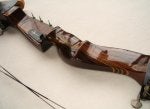Jennings through the years made alot of claims as being the first compound bow manufacturer (the facts clearly demonstrate that Allen invented and market the first compounds) and I have seen Allen bows pre-dating the issuance of his patent in 1969 but I have never seen a Jennings nor have I seen a picture of a Jennings bow prior to the early 70s. I have seen his early ads all featuring a pic from a 1967 flight contest in which the guy is shooting an Allen. But has anyone out there in AT land ever seen or have pics of a Jennings bow made before 1970???

Jennings Compound Bows pre-1970s
Neumeier
Discussion starter
27 posts
·
Joined 2009
- Add to quote Only show this user
Jennings through the years made alot of claims as being the first compound bow manufacturer (the facts clearly demonstrate that Allen invented and market the first compounds) and I have seen Allen bows pre-dating the issuance of his patent in 1969 but I have never seen a Jennings nor have I seen a picture of a Jennings bow prior to the early 70s. I have seen his early ads all featuring a pic from a 1967 flight contest in which the guy is shooting an Allen. But has anyone out there in AT land ever seen or have pics of a Jennings bow made before 1970???
2,613 posts
·
Joined 2006
jennings
jennings first ad for a compound bow that he named the compound, from an article a ( bow of compound intrest) was may 1968 ,allens first compound ( pictured ad) was july 1967.i have the adds.,and photos.
jennings first ad for a compound bow that he named the compound, from an article a ( bow of compound intrest) was may 1968 ,allens first compound ( pictured ad) was july 1967.i have the adds.,and photos.
219 posts
·
Joined 2008
1969 Jennings Compound Bow
This is a handmade 1969 Jennings Compound Bow. Brazilian Rosewood and marked "Patent Pending".
This is a handmade 1969 Jennings Compound Bow. Brazilian Rosewood and marked "Patent Pending".
Attachments
-
94.9 KB Views: 676
219 posts
·
Joined 2008
1970 Jennings Compound Bow
This is the first left-hand Compound Bow built by Tom Jennings. Ordered in the fall of 1969 and delivered in March of 1970. Has both the "Patent Pending" and the Patent number on the limbs. Brazilian Rosewood. Also Dated on the top of the riser. 3-25-70
This is the first left-hand Compound Bow built by Tom Jennings. Ordered in the fall of 1969 and delivered in March of 1970. Has both the "Patent Pending" and the Patent number on the limbs. Brazilian Rosewood. Also Dated on the top of the riser. 3-25-70
Attachments
-
123 KB Views: 2,707
2,350 posts
·
Joined 2002
Look at the pre-bend in those limbs.This is the first left-hand Compound Bow built by Tom Jennings. Ordered in the fall of 1969 and delivered in March of 1970. Has both the "Patent Pending" and the Patent number on the limbs. Brazilian Rosewood. Also Dated on the top of the riser. 3-25-70
Joe B.
219 posts
·
Joined 2008
"Patent Pending"
Tom Jennings made app. 1200 bows between Fall 1967 and the beginning of1973. 1968 and 1969 would have been the only "Patent Pending" Bows built. Probably less than 100. 1971 and 1972 had by far the most production as the Compound Bow exploded in 1973.
Tom Jennings made app. 1200 bows between Fall 1967 and the beginning of1973. 1968 and 1969 would have been the only "Patent Pending" Bows built. Probably less than 100. 1971 and 1972 had by far the most production as the Compound Bow exploded in 1973.
219 posts
·
Joined 2008
Jennings vrs. Allen
Allen made far less bows than Jennings ever did. He never wanted to produce bows, he just had no choice. Allen did get the patent for the Compound however: many believe he saw one before he made one. Tom Jennings made the Compound Bow a reality. Tom Jennings is the "God Father" of the Compound Bow!
Allen made far less bows than Jennings ever did. He never wanted to produce bows, he just had no choice. Allen did get the patent for the Compound however: many believe he saw one before he made one. Tom Jennings made the Compound Bow a reality. Tom Jennings is the "God Father" of the Compound Bow!
219 posts
·
Joined 2008
I am the second owner of both bows. They both have all original paperwork and the First Generation has the orginal case. Both bows have not had only a few dozen arrows launched. They both are quite rare.
Neumeier
Discussion starter
27 posts
·
Joined 2009
I would agree that Jennings was the chief promoter of the compound and was a far better salesman than Allen, but I do not know of any evidence that Allen was not the sole inventor of the compound. I have read of speculation too, but never have I seen any of it backed up. So IMHO Allen should be crdited with this accomplishment that has changed archery forever.
219 posts
·
Joined 2008
I agree. Wilbur Allen Made the Compund Bow and Tom Jennings made the compound bow happen. They were friends tring to change archery forever which they did. I refer to them as "Beauty nad the Beast". They covered both markets. I love my Allens.
219 posts
·
Joined 2008
First pic of the First production Allen Compound Bow.
This Allen was pictured in the April and May 1967 Archery World. It all started here.
This Allen was pictured in the April and May 1967 Archery World. It all started here.
Attachments
-
109.9 KB Views: 436
5 posts
·
Joined 2025
Not sure if you will get this as it’s old. I have a 1967 Jennings compound bow with receipts and typed owners manual. It’s in perfect condition. Do you know what it’s worth? I was thinking about donating to a museum. I’ll attach the pics
Attachments
-
2.8 MB Views: 5
-
2.8 MB Views: 6
219 posts
·
Joined 2008
Allen died in a car accident in the late 1970's. He and Tom Jennings were always friends. His widow sued Jennings and other archery manufacturers who were not paying their royalties. It broke Jennings Archery.
219 posts
·
Joined 2008
Tom Jennings handmade (by himself) pre-1970 were magnificent!
Attachments
-
115 KB Views: 540
69 posts
·
Joined 2009
I currently shoot a Browning Rage. This is considered by most to be a very conventional and conservative bow, that is it shares many of the same angular relationships with this Jennings legacy bow. The riser height and the angular relationship between riser and limbs are basicly the same. The Rage in this regard is an unremarkable bow and yet it has a very different appearance.
It makes be wonder what the conservative and uber high tech bow lineup for 2020 will look like?! I for one cant wait.
It makes be wonder what the conservative and uber high tech bow lineup for 2020 will look like?! I for one cant wait.
36 posts
·
Joined 2009
For what it's worth:
I owned and shot Allen bows in the late 1960's and early 1970's and also owned and shot Jennings' in both indoor league and hunting situations.
Clearly, the Jennings were a more refined item. I was driving to Monett, MO in 1976 and while southhbound below Springfield, MO, glanced at the right side of the road and saw a modest garage almost AT the side of the road with a sign on its upper edge indicating it was the "home of the Allen compound bow". I stopped and spoke with Mr. Allen, who I want to recall, preferred "Harold" to his given name of Holless. He appeared to be in his early 50's, in good health, rather quiet, but very polite. He told me that he'd searched for a way to get more velocity to minimize string jumping. He volunteered nothing about the pre-patent history of the compound bow or that he was motivated by arthritis in his shoulders. Since he had been working on the bow for many years, I imagine he was in his early 40's then and probably not arthritic, as some claim.
I have a good friend in that area who was an active target and hunting archer out of Galena, KS and Joplin, MO. He said that Mr. Allen was rarely seen in archery shops or at archery related events. He has forgotten his occupation, but also visited him a couple times.
A while back I searched "compound" bows, etc. and found a reference to bows with pulleys and wheels in the 1930's in the Eastern US area. My Missouri friend recalls seeing bows with wheels on the SIDES of limbs before Allen's patent.
The lawsuit over patent royalites is public information and so would be the patent application, which should include related historical details on any earlier bows of that type. The family had several that were parties to the lawsuit so maybe one or more can enlighten us further.
Regards,
Kevin
I owned and shot Allen bows in the late 1960's and early 1970's and also owned and shot Jennings' in both indoor league and hunting situations.
Clearly, the Jennings were a more refined item. I was driving to Monett, MO in 1976 and while southhbound below Springfield, MO, glanced at the right side of the road and saw a modest garage almost AT the side of the road with a sign on its upper edge indicating it was the "home of the Allen compound bow". I stopped and spoke with Mr. Allen, who I want to recall, preferred "Harold" to his given name of Holless. He appeared to be in his early 50's, in good health, rather quiet, but very polite. He told me that he'd searched for a way to get more velocity to minimize string jumping. He volunteered nothing about the pre-patent history of the compound bow or that he was motivated by arthritis in his shoulders. Since he had been working on the bow for many years, I imagine he was in his early 40's then and probably not arthritic, as some claim.
I have a good friend in that area who was an active target and hunting archer out of Galena, KS and Joplin, MO. He said that Mr. Allen was rarely seen in archery shops or at archery related events. He has forgotten his occupation, but also visited him a couple times.
A while back I searched "compound" bows, etc. and found a reference to bows with pulleys and wheels in the 1930's in the Eastern US area. My Missouri friend recalls seeing bows with wheels on the SIDES of limbs before Allen's patent.
The lawsuit over patent royalites is public information and so would be the patent application, which should include related historical details on any earlier bows of that type. The family had several that were parties to the lawsuit so maybe one or more can enlighten us further.
Regards,
Kevin
876 posts
·
Joined 2003
first compound
the first compound i ever saw was an allen. it was at an indoor tourn. in joplin,mo. in 1968. mr. allen did not shoot in the tourn. he just wanted people to see it. i can remember everyone looking at it and saying it would never work. were we ever wrong. that bow on the table that day changed archery forever.
i purchased a jennings in 1974 (which i still have) and have been shooting a compound ever since.
the first compound i ever saw was an allen. it was at an indoor tourn. in joplin,mo. in 1968. mr. allen did not shoot in the tourn. he just wanted people to see it. i can remember everyone looking at it and saying it would never work. were we ever wrong. that bow on the table that day changed archery forever.
i purchased a jennings in 1974 (which i still have) and have been shooting a compound ever since.
219 posts
·
Joined 2008
This is the first and second Jennings Compound Bow. The first left hand Jennings ever made. Thanks Dan
29,454 posts
·
Joined 2007
Dan was correct about Mr Allen being killed in an auto accident, but the reason that the suit was pushed so far was that Mr Allen was killed on the way to court on the law suit.
-
?
-
?
-
?
-
?
-
?
-
?
-
?
-
?
-
?
-
?
-
?
-
?
-
?
-
?
-
?
-
?
-
?
-
?
-
?
-
?
- posts
- 39M
- members
- 241K
- Since
- 2001
A forum community dedicated to bow and crossbow owners and archery enthusiasts. Come join the discussion about optics, hunting, performance, troubleshooting, styles, reviews, accessories, classifieds, and more!
Top Contributors this Month
View All
Arrowbender
1.2K Replies
toddcbrown
649 Replies
Mossy-Back
636 Replies









